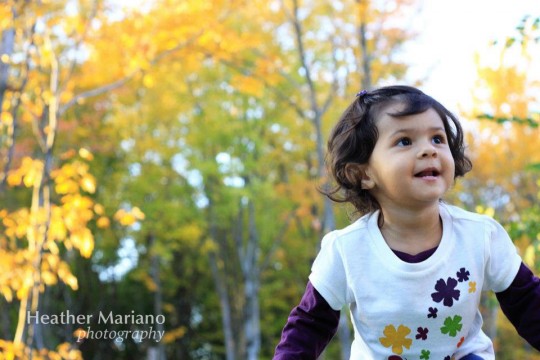Blog
DSLR Love: Improve Your Photo Mojo (Part Two)

ISO
ISO is one aspect of photography that is not exactly the same in the film and digital realms, but they are related. In film, ISO referred to the films light sensitivity or speed. This meant shooting 100 film would allow for a finer grain than shooting with 800 film. Typically the recommendation or guideline I followed was to shoot with 100 film in daylight and 400 film inside or in lower light (evening) like the image below.
In the digital age, ISO is still related to light sensitivity, but since you are not dealing with film it is the image sensor that is sensitive to light. The numbers mean the same thing in digital as they do in film, so the higher the number, the more grainy the image. Not too confusing once you start experimenting and comparing the images with different ISO settings. Many photographers don’t recommend going over 1600 unless you are purposely going for the grainy look. When photographing families and kids as I enjoy doing on evenings and weekends, I aim to keep my ISO between 100-400. If I’m shooting indoors, I’ll bump it up to 500-800 if needed.

This article does a great job explaining ISO as well.
Aperture
Aperture is possibly one of my favorite settings to play with when I take proper time between shots because it can impact an image in dramatic ways. Aperture refers to the size of the lens opening which dictates how much light reaches the film (SLR) or image sensor (DSLR). Aperture does not impact an image on its own, it works in combination with shutter speed. Shutter speed is another very important component because it governs how long the shutter stays open, exposing light to the film or image sensor. When I studied film photography in high school and college, the general rule of thumb for shooting without a tripod was to not go below 1/60 for your shutter speed (1/60 refers to 1/60 of a second). Anything below 1/60 could be blurry from camera shake, you know since we’re human and all. Currently I don’t shoot with that low of a shutter speed when photographing kids, have you noticed how fast they can move? Staying higher than 1/100 is usually a good bet for me. I don’t mind some good motion blur, but if I’m going for a focused shot I don’t want that blur on every image.
Back to Aperture… Once you have your shutter speed determined, you can go about setting your aperture or vice versa if you’re shooting in aperture priority, the A setting. I tend to shoot in aperture priority mode when photographing kids because I like to make sure that the my depth of field is exactly as I want it for my subject. Depth of field is directly related to aperture – the lower the aperture, the shallower your depth of field, the higher your aperture, the deeper your depth of field. The following image is an example of a wide depth of field.
In simple terms, when your aperture or f-stop is low (f-stop 1.8, 2.2, 2.8) the items in the background are blurry, and when your aperture is high (f-stop 11, 16, 22) the items in your foreground and background are both in focus. For example, this photograph of a newborn was shot with a low aperture setting to ensure that anything in the background would not distract from the main focus, the baby’s head and hair.
When I’m shooting a group or a family, I will often increase the aperture so that one person is not out of focus and another person is in focus. I’ll often ramp up that aperture if the background will add more interest to the image as well.
So there it is, a crash course on ISO, Aperture, depth of field, and shutter speed. What part has confused you the most since you picked up your SLR or DSLR camera? What is your favorite setting to lead with ISO, aperture, shutter speed? Are any of these settings still a mystery?


